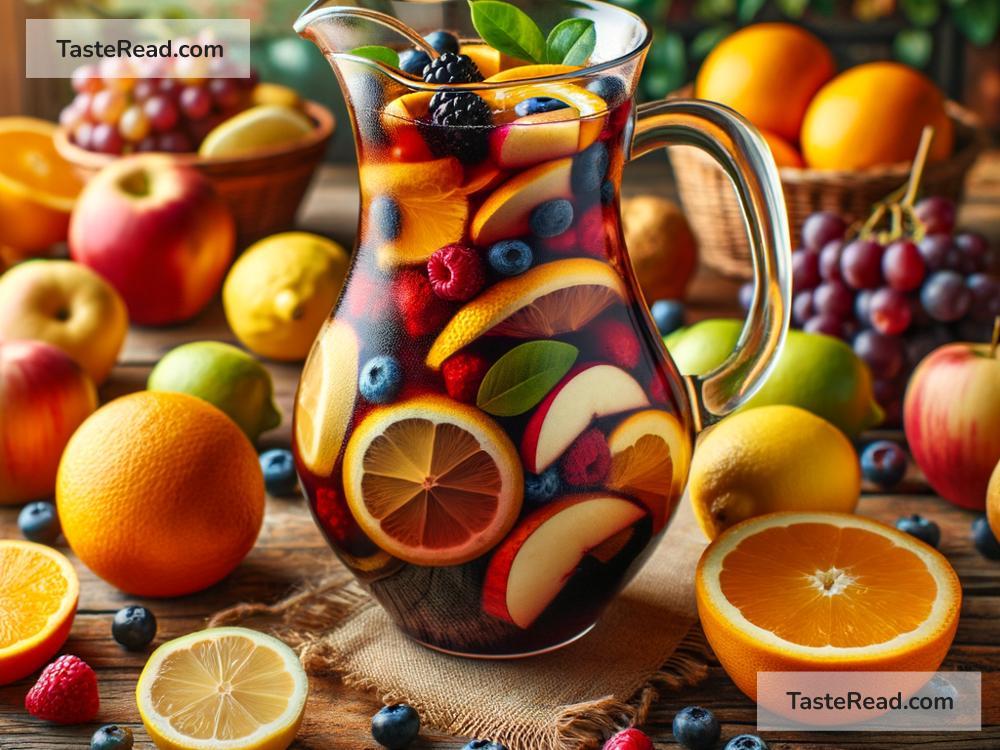The Sweet History of Spanish Sangria
Sangria is one of Spain’s most famous drinks, known for its fruity flavors and refreshing taste. Whether you’re enjoying a sunny day by the beach or hosting a dinner party, sangria is a favorite beverage for many people around the world. But where did sangria come from? How did it develop into the drink we know and love today? In this article, we’ll explore the fascinating history and evolution of Spanish sangria, explained simply.
What is Sangria?
Before diving into its history, let’s first talk about what sangria is. Sangria is a wine-based drink that usually includes chopped fruits, such as oranges, apples, berries, and lemons. It’s mixed with spices, juice, and sometimes a splash of brandy or soda for a fizzy touch. The key ingredient in traditional sangria is red wine, although today you can also find sangria made with white or rosé wine.
The word “sangria” comes from the Spanish word sangre, which means “blood.” This is likely a reference to the drink’s deep red color when it’s first made with red wine.
The Origins of Sangria
The roots of sangria can be traced all the way back to ancient times. During the Roman Empire (around 200 BCE), wine was commonly consumed across Europe. However, wine was often mixed with water, herbs, and fruits to make it safer to drink. This was done because water during that time wasn’t always clean and could lead to illness, while wine acted as a natural disinfectant. This early version of sangria developed over time as people experimented with different recipes.
Fast forward several centuries to the Middle Ages, and wine mixed with fruit was still a popular drink in Europe. Spices like cinnamon and cloves were increasingly added to enhance the flavor, especially as trade routes expanded and exotic ingredients became more available. Spain, with its ideal climate for growing grapes and citrus fruits, became one of the leading countries for producing flavorful wines. This set the stage for sangria to become a signature Spanish drink.
Sangria in Spanish Culture
Sangria as we know it began to take shape in the 18th and 19th centuries in Spain. Spanish winemakers started creating more distinct blends of wine, and locals experimented with adding fresh fruits, juice, and spices to create refreshing beverages. The drink became especially popular in southern Spain, where warm weather made chilled sangria appealing. It was often served at celebrations, gatherings, and tapas bars, becoming a symbol of Spanish hospitality.
For much of its early development, sangria was a regional drink enjoyed mainly by Spaniards. It wasn’t widely known outside of Europe. However, this changed in the mid-20th century when sangria made its big debut on the international stage.
Sangria Goes Global
The turning point for sangria came in 1964 during the New York World’s Fair, an event that showcased different cultures, art, and food from all over the world. Spain had its own pavilion at the fair, and one of the highlights offered to visitors was sangria. Tourists loved the sweet, fruity flavor and relaxed vibe associated with the drink. It quickly became a hit in the United States, where people saw it as the perfect blend of sophistication and fun.
From there, sangria gained popularity in other countries, particularly in warmer regions where people craved refreshing beverages. Restaurants started including sangria on their menus, and it wasn’t long before it became a global sensation. Today, you can find sangria served all around the world — each place adding its own twist to the traditional recipe.
Modern Sangria: Endless Variations
In modern times, sangria has evolved to suit different tastes and preferences. While red wine sangria is still the classic version, many people enjoy white sangria made with white wine or rosé sangria, which has a lighter, floral flavor. Additionally, some recipes ditch wine altogether and use sparkling wine, cider, or even beer as the base.
The types of fruits and spices added to sangria also vary depending on where you are. Traditional Spanish sangria usually includes oranges and lemons, but in the U.S., strawberries and peaches are common additions. In tropical regions, mango or pineapple might be added for an exotic twist. The beauty of sangria lies in its flexibility — you can experiment with flavors to create your perfect version.
Sangria Today: A Symbol of Fun and Friendship
Sangria isn’t just a drink; it’s a symbol of joy, relaxation, and togetherness. Whether you’re sipping sangria at a Spanish fiesta or at a backyard barbecue, the drink is all about bringing people together to share a good time. Its vibrant colors and fruity flavors make sangria feel festive no matter the occasion.
Today, sangria is even more popular than ever, with countless recipes available online and in cookbooks. You can buy pre-made sangria in stores or make your own customized version at home. Thanks to its simple ingredients and endless possibilities, sangria continues to be a beloved drink for people of all ages.
Conclusion
The development of Spanish sangria is a story of creativity, tradition, and sharing. From its humble beginnings as a mixed wine drink in ancient times to its international fame today, sangria has come a long way. It’s a drink that reflects the warmth and spirit of Spanish culture, inviting us to slow down and enjoy life’s simple pleasures.
So the next time you sip a glass of sangria, remember the rich history behind it — and don’t forget to share it with friends!


